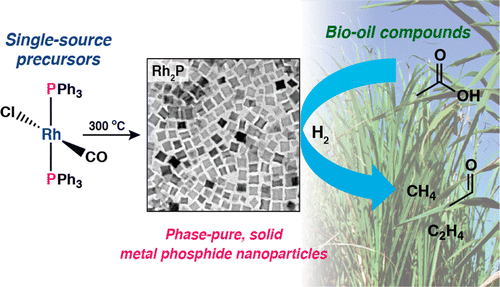当前位置:
X-MOL 学术
›
Chem. Mater.
›
论文详情
Our official English website, www.x-mol.net, welcomes your
feedback! (Note: you will need to create a separate account there.)
A Facile Molecular Precursor Route to Metal Phosphide Nanoparticles and Their Evaluation as Hydrodeoxygenation Catalysts
Chemistry of Materials ( IF 7.2 ) Pub Date : 2015-11-05 00:00:00 , DOI: 10.1021/acs.chemmater.5b02140 Susan E. Habas 1 , Frederick G. Baddour 1 , Daniel A. Ruddy 1 , Connor P. Nash 1 , Jun Wang 1 , Ming Pan 1 , Jesse E. Hensley 1 , Joshua A. Schaidle 1
Chemistry of Materials ( IF 7.2 ) Pub Date : 2015-11-05 00:00:00 , DOI: 10.1021/acs.chemmater.5b02140 Susan E. Habas 1 , Frederick G. Baddour 1 , Daniel A. Ruddy 1 , Connor P. Nash 1 , Jun Wang 1 , Ming Pan 1 , Jesse E. Hensley 1 , Joshua A. Schaidle 1
Affiliation

|
Metal phosphides have been identified as a promising class of materials for the catalytic upgrading of bio-oils, which are renewable and potentially inexpensive sources for liquid fuels. Herein, we report the facile synthesis of a series of solid, phase-pure metal phosphide nanoparticles (NPs) (Ni2P, Rh2P, and Pd3P) utilizing commercially available, air-stable metal–phosphine complexes in a one-pot reaction. This single-source molecular precursor route provides an alternative method to access metal phosphide NPs with controlled phases and without the formation of metal NP intermediates that can lead to hollow particles. The formation of the Ni2P NPs was shown to proceed through an amorphous Ni–P intermediate, leading to the desired NP morphology and metal-rich phase. This low-temperature, rapid route to well-defined metal NPs is expected to have broad applicability to a variety of readily available or easily synthesized metal–phosphine complexes with high decomposition temperatures. Hydrodeoxygenation of acetic acid, an abundant bio-oil component, was performed to investigate H2 activation and deoxygenation pathways under conditions that are relevant to ex situ catalytic fast pyrolysis (high temperatures, low pressures, and near-stoichiometric H2 concentrations). The catalytic performance of the silica-supported metal phosphide NPs was compared to the analogous incipient wetness (IW) metal and metal phosphide catalysts over the range 200–500 °C. Decarbonylation was the primary pathway for H2 incorporation in the presence of all of the catalysts except NP-Pd3P, which exhibited minimal productive activity, and IW-Ni, which evolved H2. The highly controlled NP-Ni2P and NP-Rh2P catalysts, which were stable under these conditions, behaved comparably to the IW-metal phosphides, with a slight shift to higher product onset temperatures, likely due to the presence of surface ligands. Most importantly, the NP-Ni2P catalyst exhibited H2 activation and incorporation, in contrast to IW-Ni, indicating that the behavior of the metal phosphide is significantly different from that of the parent metal, and more closely resembles that of noble metal catalysts.
中文翻译:

金属磷酸盐纳米粒子的简便分子前体路线及其作为加氢脱氧催化剂的评价
金属磷化物已被认为是用于催化提质生物油的有前途的一类材料,生物油是可再生的并且可能是廉价的液体燃料来源。本文中,我们报告了利用一种可在市场上购买的,空气稳定的金属-膦复合物轻松合成一系列固态,纯相金属磷化物纳米颗粒(NPs)(Ni 2 P,Rh 2 P和Pd 3 P)的方法。 -锅反应。这种单一来源的分子前体途径提供了一种可替代的方法,可访问具有受控相的金属磷化物NP,而不会形成可导致空心颗粒的金属NP中间体。Ni 2的形成P NPs通过无定形的Ni-P中间产物进行,导致所需的NP形态和富金属相。预期这种低温,快速的途径可以使金属NPs明确定义,并广泛适用于各种易于获得或合成的具有高分解温度的金属-膦配合物。在与异位催化快速热解有关的条件下(高温,低压和接近化学计量的H 2),对乙酸(一种丰富的生物油成分)进行了加氢脱氧研究,以研究H 2的活化和脱氧途径。浓度)。在200–500°C的温度范围内,将二氧化硅负载的金属磷化物NPs的催化性能与类似的初期湿润(IW)金属和金属磷化物催化剂进行了比较。在所有催化剂的存在下,脱羰基是H 2掺入的主要途径,除了NP-Pd 3 P和IW-Ni,NP-Pd 3 P表现出最小的生产活性,而IW-Ni释放出H 2。在这些条件下稳定的高度受控的NP-Ni 2 P和NP-Rh 2 P催化剂的性能与IW-金属磷化物相当,可能略微转变为更高的产物起始温度,这可能是由于表面配体的存在。最重要的是NP-Ni 2与IW-Ni相比,P催化剂表现出H 2活化和结合,表明金属磷化物的行为与母体金属的行为显着不同,并且与贵金属催化剂的行为更相似。
更新日期:2015-11-05
中文翻译:

金属磷酸盐纳米粒子的简便分子前体路线及其作为加氢脱氧催化剂的评价
金属磷化物已被认为是用于催化提质生物油的有前途的一类材料,生物油是可再生的并且可能是廉价的液体燃料来源。本文中,我们报告了利用一种可在市场上购买的,空气稳定的金属-膦复合物轻松合成一系列固态,纯相金属磷化物纳米颗粒(NPs)(Ni 2 P,Rh 2 P和Pd 3 P)的方法。 -锅反应。这种单一来源的分子前体途径提供了一种可替代的方法,可访问具有受控相的金属磷化物NP,而不会形成可导致空心颗粒的金属NP中间体。Ni 2的形成P NPs通过无定形的Ni-P中间产物进行,导致所需的NP形态和富金属相。预期这种低温,快速的途径可以使金属NPs明确定义,并广泛适用于各种易于获得或合成的具有高分解温度的金属-膦配合物。在与异位催化快速热解有关的条件下(高温,低压和接近化学计量的H 2),对乙酸(一种丰富的生物油成分)进行了加氢脱氧研究,以研究H 2的活化和脱氧途径。浓度)。在200–500°C的温度范围内,将二氧化硅负载的金属磷化物NPs的催化性能与类似的初期湿润(IW)金属和金属磷化物催化剂进行了比较。在所有催化剂的存在下,脱羰基是H 2掺入的主要途径,除了NP-Pd 3 P和IW-Ni,NP-Pd 3 P表现出最小的生产活性,而IW-Ni释放出H 2。在这些条件下稳定的高度受控的NP-Ni 2 P和NP-Rh 2 P催化剂的性能与IW-金属磷化物相当,可能略微转变为更高的产物起始温度,这可能是由于表面配体的存在。最重要的是NP-Ni 2与IW-Ni相比,P催化剂表现出H 2活化和结合,表明金属磷化物的行为与母体金属的行为显着不同,并且与贵金属催化剂的行为更相似。






























 京公网安备 11010802027423号
京公网安备 11010802027423号